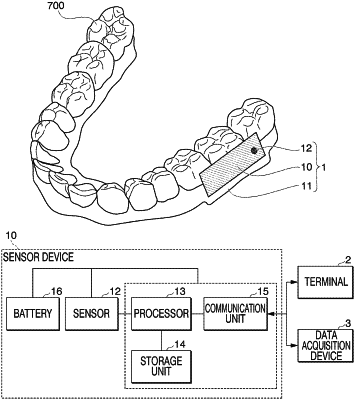| CPC A61B 5/0002 (2013.01) [A61B 5/682 (2013.01); H04Q 9/00 (2013.01); A61B 2560/0209 (2013.01); H04Q 2209/43 (2013.01)] | 8 Claims |

|
1. A biological monitoring device comprising:
a sensor included in an electronic device, wherein the sensor is configured to perform a detection process of detecting a medical condition in a body of a patient, and perform a process of generating first detection data indicating a result of the detection process; and
the electronic device comprising a processor, wherein the processor is configured to cause the electronic device to:
perform a process of generating second detection data indicating contents related to the detection process and having a smaller data volume than the first detection data, on the basis of the first detection data;
determine whether or not the electronic device exists in the body of the patient, on the basis of at least one of the first detection data and the second detection data;
cause the sensor to perform the process of generating the first detection data, when it is determined that the electronic device exists in the body of the patient;
perform a process of transmitting the second detection data to a terminal associated with the patient in a first cycle;
when it is determined that the electronic device does not exist in the body of the patient:
transmit the second detection data to the terminal in a second cycle shorter than the first cycle,
calculate a time during which the electronic device does not exist in the body of the patient, on the basis of at least one of the first detection data and the second detection data, and further to determine whether or not the time exceeds a predetermined threshold, and
when it is determined that the time exceeds the predetermined threshold, lengthen the second cycle within a range not exceeding a length of the first cycle, or lengthen the second cycle regardless of the length of the first cycle.
|